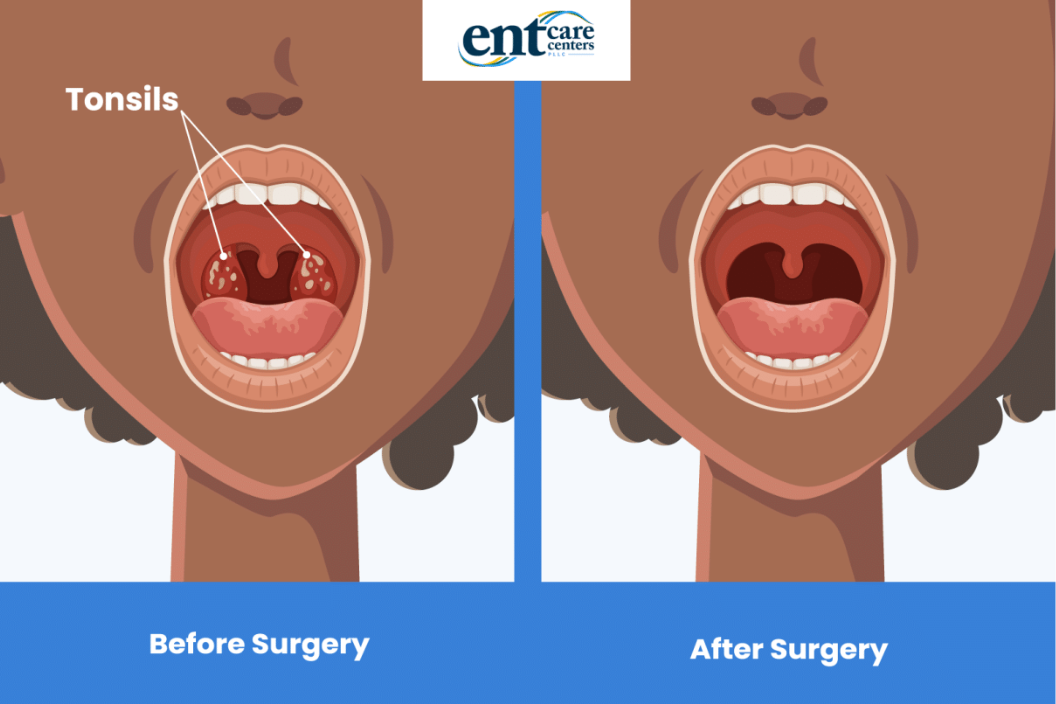Tonsillectomy
Are you considering a tonsillectomy for yourself or a loved one? Are you feeling overwhelmed with the amount of information out there? Don't worry, we have you covered! In this article, we will provide all the information you need to know about tonsillectomies so that you can make an informed decision.
What is Tonsillectomy?
A tonsillectomy is a surgical procedure in which both palatine tonsils are fully removed from the back of the throat. The procedure is mainly performed for recurrent tonsillitis, throat infections, and obstructive sleep apnea. Tonsils are two small glands located at the back of your throat which help the immune system fight off infections. During a tonsillectomy, the tonsils are carefully removed using special instruments. Once the procedure is complete, your doctor will use stitches or cauterization to close the wounds and prevent bleeding.

When is Tonsillectomy Necessary?
A tonsillectomy may be necessary if someone gets a lot of tonsil infections (called recurrent tonsillitis), has difficulty swallowing, persistent pain, swelling of the throat, or obstructive sleep apnea. Children who are severely affected by recurrent throat infections (more than seven episodes in the past year, or five episodes per year for two consecutive years) may also be candidates for a tonsillectomy. In some cases, a health care provider may recommend watchful waiting to see if the infections lessen over time. However, if the infections persist, a tonsillectomy may be necessary. The good news is that research has shown that having your tonsils removed may significantly reduce the rate of infection for chronic sufferers.
Preparing for the Procedure
Preparing for a tonsillectomy can be an important part of ensuring a successful procedure and recovery. Before the surgery, it is important to follow your doctor’s instructions to make sure you are ready for the operation. This may include completing any blood work or other doctor appointments, as directed by your surgeon, in a timely manner. You should also refrain from taking aspirin or other medications containing aspirin for at least two weeks before the surgery. Additionally, your doctor may ask you to stop taking some medications or change dosages of medications several days before the operation. On the day of surgery, you will not be allowed to eat or drink anything, including water, after midnight. Make sure to discuss any questions or concerns with your doctor before the procedure.
What Happens During a Tonsillectomy?
During the procedure, a surgeon will remove the tonsils and any surrounding tissue that may be affected by infection or inflammation. The surgeon may cut out the tonsils using a blade (scalpel) or a specialized surgical tool that uses heat, high-energy heat, or sound waves to remove or destroy tissues. In some cases, a laser may be used to perform the procedure. After the surgery, the patient will be monitored for any potential complications, such as bleeding, infection, or swelling. Pain medications will be prescribed to help with discomfort and recovery.
Postoperative Care and Recovery
To relieve symptoms of chronic tonsillitis, such as sore throat and difficulty swallowing, tonsillectomy is usually done. Post operative care and recovery are important for a successful outcome after the surgery.
The recovery period following a tonsillectomy can vary from person to person, but it typically takes seven to 10 days for most people. It is important to get plenty of rest during this time and avoid strenuous physical activity. Children may return to school when they feel comfortable, though the average time is one week. Adults typically start transitioning into their daily routines after about 12–14 days. Adults may need up to 14 days off of work after tonsillectomy, especially if the job is strenuous in nature.
After surgery, children should rest but may play inside after one or two days and may be outside after three or four days, if they feel up to it. It is important to drink plenty of fluids during the recovery period and avoid using aspirin or other blood thinners for one to two weeks prior to and one to two weeks after surgery. Eating may be difficult after the procedure; only 55% of children will eat normally by the end of the first week. Generally, a normal diet is encouraged once discharged from the hospital.
Oral and nasal care are important following a tonsillectomy. The back of the throat is usually red, white, and swollen during the first few days after surgery. As the swelling subsides, patients should rinse their mouths
Potential Complications of Tonsillectomy
When undergoing a tonsillectomy procedure, there is always the risk of potential complications. The most common issues are moderate to severe pain in the throat for one to two weeks, pain in the ears, neck or jaw, nausea and vomiting, and postoperative infection. Other potential complications include delayed hemorrhage (2–4% of all patients), edema of the tongue, glossopharyngeal nerve injury, and cervicofacial surgical emphysema. It is important to be aware of these potential risks before undergoing a tonsillectomy and to contact your doctor right away if you experience any of these symptoms after the surgery.
Tips for Reducing Pain After the Surgery
After the procedure, it is important to take special care to reduce pain and other potential complications. Here are some tips for reducing pain after a tonsillectomy:
- Take prescribed pain medications as directed by your doctor. This may include acetaminophen, ibuprofen, or stronger prescription-only medicines. Please ask your surgeon about their specific recommendations for pain control.
- Eat cold things: Cold foods and fluids can help reduce swelling and pain.
- Chewing gum may be helpful in reducing muscle spasms and is encouraged.
- Take an oral corticosteroid, if prescribed, after surgery may help reduce swelling and pain.
- Get plenty of rest. In the days following your tonsil surgery, it's important to take it easy.
- Avoid using codeine in children after the surgery.
- Never take aspirin or other blood thinners for one to two weeks after surgery. By following these tips, you may be able to reduce discomfort and speed up recovery time following your tonsillectomy.
- Be sure to discuss any concerns with your surgeon prior to surgery.
Eating and Drinking After Surgery
When recovering from a tonsillectomy, it is important to stay hydrated and provide your body with the nutrients it needs to heal. After the first day or two, start adding cold and soothing foods such as ice cream, frozen yogurt, Jell-O, and other soft foods such as pasta, puddings, mashed potatoes, tuna or chicken salad, and macaroni and cheese. Avoid sharp, hot, or spicy foods that could irritate the throat. Start with small amounts of food and increase as tolerated. Cold liquids are very important for rehydration after surgery. Start with cold water and then add other cold liquids such as juice or milk. Avoid citrus juices, as they can sting. If you are having difficulty swallowing liquids after surgery, consider popsicles or ice chips to help keep your throat lubricated. To reduce swelling in the throat, try eating porridge that has been cooled down. It is also important to avoid getting overheated or overtired during the first few weeks of recovery
Dealing With Swelling After Surgery
Swelling is a common side effect of tonsillectomy. It can cause discomfort and pain, and can also lead to difficulty breathing and eating. The swelling usually peaks around the third or fourth day after surgery and gradually decreases over the next two weeks. Fortunately, there are a few simple measures that you can take to reduce the swelling.
It is important to rest after the surgery and avoid strenuous activities. Mild exercise such as walking can help to reduce swelling, but strenuous activities should be avoided for at least the first week after surgery. Additionally, it is important to keep your head elevated when sleeping. This will help to reduce swelling by decreasing the amount of fluid that accumulates in your throat.
It is also recommended to gargle with salt water several times a day. Mix one teaspoon of salt with 8 ounces of warm water and gargle for at least 30 seconds. This will help to reduce inflammation and pain. Applying an ice pack or cold compress to the neck can also help to reduce swelling and discomfort. It is best to apply the cold pack for 10 minutes at a time, several times a day
Side Effects of Tonsillectomy
While tonsillectomy procedure is generally safe, it does come with some potential side effects. The most common side effects of tonsillectomy include pain and swelling in the throat, ear pain, nausea, vomiting, bad breath, and feeling something stuck in the throat. These effects can last for up to two weeks after the surgery. In rare cases, delayed bleeding and infection can occur. If you experience any of these symptoms, it's important to contact your doctor right away. Other potential side effects include difficulty swallowing, coughing up blood, fever, and sore throat. Taking over-the-counter medications such as acetaminophen can help reduce pain and swelling. It's also important to drink plenty of fluids and get plenty of rest to help with recovery.
Antibiotic Use Following Surgery
Antibiotics are not routinely used after tonsillectomy. Research suggests that antibiotics may not reduce the risk of postoperative infection and may even increase the risk of nausea, vomiting, and abdominal pain. The American
Academy of Otolaryngology-Head and Neck Surgery recommends that antibiotics should only be used when infection is present or anticipated. In such cases, antibiotics should be prescribed for three days only. It is important to note that antibiotics should not be used as a preventative measure after tonsillectomy.
Managing Bleeding After the Procedure
After a tonsillectomy, bleeding is a potential complication that should be managed properly. If a patient is actively bleeding, the patient should be taken urgently for control of the hemorrhage. Until the patient is transferred to the operating room, if hemorrhaging is significant, direct pressure, either with a throat pack or gauze, should be applied to the tonsillar fossa to control the bleeding.
Post-tonsillectomy bleeding is thought to occur in approximately 5%of cases following tonsil surgery and can occur in the first 24 hours following the operation (reactive), or later (secondary). Secondary post-tonsillectomy bleeds, defined as any bleeding that occurs 24 hours or longer after surgery, is estimated to occur in approximately 2–5%. To reduce the risk of postoperative bleeding, patients should avoid coughing, nose-blowing, clearing the throat, and spitting. Wiping the nose gently and sneezing in a pillow should also be encouraged in order to reduce any potential damage caused by forceful air movements. If your child experiences any signs of excessive bleeding, such as light-headedness or difficulty breathing, they should be taken to a doctor immediately.
Knowing When to Contact Your Doctor
It is important to monitor your symptoms and contact your doctor if you have any questions or concerns. If any of the following occur, contact your doctor immediately:
- Severe throat pain or difficulty swallowingWhite spots on your tonsils
- Pain on one side of the throat
- Fever higher than 100.4°F (38°C) or lasting more than two days
- Bleeding that won’t stop after 10 minutes of direct pressure
- Difficulty breathing or swallowing
- Severe pain that doesn’t respond to prescribed pain medications
- Excessive swelling in the throat or neck area
- Signs of infection, such as redness, warmth, and drainage from thesurgery site
Returning to Normal Activity Levels
When it comes to returning to normal activity levels after a tonsillectomy, it is important to remember that recovery takes time. While your child may feel tired for the first few days, they should gradually become more active. Most children can return to school or daycare in a week, but it can take up to two weeks for them to return to their full activity level. It is important to take it slow and not push your child too hard. They should be encouraged to get plenty of rest and sleep with their head elevated at a 30-45 degree angle. Light activity is recommended and activities can be increased slowly as strength returns. Pain medication should be taken as prescribed by your doctor. Eating should be done in small amounts and a normal diet is usually recommended. It may take up to two weeks before your child can return to their normal activity level. During this time, be sure to watch your child for any signs of complications such as excessive bleeding or difficulty breathing. If you notice any of these signs, contact your doctor right away.
Conclusion
In conclusion, it is important to understand all aspects of tonsillectomy before having the procedure. Tonsillectomy can be a beneficial procedure for many people, but it does come with risks and potential complications. It is important to discuss the risks and benefits of tonsillectomy with your doctor before deciding whether it is the right choice for you. Post-operative care is also essential to ensure a successful recovery, including proper rest, hydration, and minimizing physical activity. If you experience any abnormal symptoms or significant pain during or after the procedure, contact your doctor immediately.
Medical Reviewers
Last Review Date: January 2023
Content Reviewers:
- Dr. Jeffrey Nau, MD
- Dr. JosephJ. Creely, MD
- Dr. Bryan Murphy, MD
- Dr. Thomas Higgins, MD, MSPH



